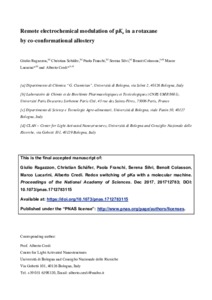Ragazzon, Giulio ; Schaefer, Christian ; Franchi, Paola ; Silvi, Serena ; Colasson, Benoit ; Lucarini, Marco ; Credi, Alberto
(2017)
Remote electrochemical modulation of pKa in a rotaxane by co-conformational allostery.
Proceedings of the National Academy of Sciences of the United States of America, NA
.
pp. 1-6.
Full text disponibile come:
![[thumbnail of Final Accepted Manuscript]](http://amsacta.unibo.it/5809/1.hassmallThumbnailVersion/Remote%20pKa%20modulation-text_rev_clean.pdf)  Anteprima |
Documento di testo(pdf) (Final Accepted Manuscript)
Licenza: Salvo eventuali più ampie autorizzazioni dell'autore, il contributo può essere liberamente consultato e può essere effettuato il salvataggio e la stampa di una copia per fini strettamente personali di studio, di ricerca e di insegnamento, con espresso divieto di qualunque utilizzo direttamente o indirettamente commerciale. Ogni altro diritto sul materiale è riservato.
Download (3MB)
| Anteprima
|
Abstract
Allosteric control, one of Nature’s most effective ways to regulate functions in biomolecular machinery, involves the transfer of information between distant sites. The mechanistic details of such a transfer are still object of intensive investigation and debate, and the idea that the intramolecular communication could be enabled by dynamic processes is gaining attention as a complement to traditional explanations. Mechanically interlocked molecules, owing to the particular kind of connection between their components and the resulting dynamic behavior, are attractive systems to investigate allosteric mechanisms and exploit them to develop functionalities with artificial species. We show that the pKa of an ammonium site located on the axle component of a [2]rotaxane can be reversibly modulated by changing the affinity of a remote recognition site for the interlocked crown ether ring through electrochemical stimulation. The use of a reversible ternary redox switch enables us to set the pKa to three different values, encompassing more than 7 units. Our results demonstrate that in the axle the two sites do not communicate, and that in the rotaxane the transfer of information between them is made possible by the shuttling of the ring, that is, by a dynamic intramolecular process. The investigated coupling of electron- and proton-transfer reactions is reminiscent of the operation of the protein complex I of the respiratory chain.
Abstract
Allosteric control, one of Nature’s most effective ways to regulate functions in biomolecular machinery, involves the transfer of information between distant sites. The mechanistic details of such a transfer are still object of intensive investigation and debate, and the idea that the intramolecular communication could be enabled by dynamic processes is gaining attention as a complement to traditional explanations. Mechanically interlocked molecules, owing to the particular kind of connection between their components and the resulting dynamic behavior, are attractive systems to investigate allosteric mechanisms and exploit them to develop functionalities with artificial species. We show that the pKa of an ammonium site located on the axle component of a [2]rotaxane can be reversibly modulated by changing the affinity of a remote recognition site for the interlocked crown ether ring through electrochemical stimulation. The use of a reversible ternary redox switch enables us to set the pKa to three different values, encompassing more than 7 units. Our results demonstrate that in the axle the two sites do not communicate, and that in the rotaxane the transfer of information between them is made possible by the shuttling of the ring, that is, by a dynamic intramolecular process. The investigated coupling of electron- and proton-transfer reactions is reminiscent of the operation of the protein complex I of the respiratory chain.
Tipologia del documento
Articolo
Autori
Settori scientifico-disciplinari
DOI
Data di deposito
30 Mar 2018 10:18
Ultima modifica
19 Giu 2018 21:00
Nome del Progetto
Programma di finanziamento
EC - H2020
URI
Altri metadati
Tipologia del documento
Articolo
Autori
Settori scientifico-disciplinari
DOI
Data di deposito
30 Mar 2018 10:18
Ultima modifica
19 Giu 2018 21:00
Nome del Progetto
Programma di finanziamento
EC - H2020
URI
Statistica sui download
Statistica sui download
Gestione del documento:



 Login per gli autori
Login per gli autori



